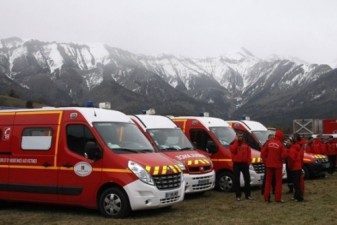
25/03/2015 13:54
What happened to Germanwings flight 4U 9525?
The crash of Germanwings flight 4U9525 in the French Alps with the presumed loss of 150 lives occurred after an unexplained and relatively smooth eight-minute descent.
The Airbus A320 left Barcelona at 10.01am en route to Düsseldorf and had just plateaued at its highest cruising altitude of 38,000ft at 10.45am. About a minute later, it started to descend, crashing into the mountains at 6,000ft.
The captain had more than 10 years of experience and had clocked up more than 6,000 flight hours on the Airbus model. The A320 was on its second flight of the day, having earlier left Düsseldorf for Barcelona, landing at 8.57am, before its second takeoff for the short 90-minute flight.
After earlier contradictory reports, France’s aviation authority confirmed on Tuesday evening that the pilots had not sent out a distress call and had lost radio contact with their control centre, deepening the mystery over the cause of the crash. No request was made to start a descent.
Plane maintenance history
The German budget airline, the low-cost subsidiary of national carrier Lufthansa, said the plane had been given a routine maintenance check by Lufthansa technicians on Monday, while its last C-check – a major inspection that can take a plane out of service for a week – was conducted according to the manufacturer’s schedule in 2013.
Thomas Winkelmann, the chief executive of Germanwings, said there were no irregular aspects with the plane, one of the earlier A320s, which was delivered to Lufthansa in 1991 and had been in service for Germanwings since 2001. “As long as you have your maintenance schedule in place with the manufacturers, there is absolutely no issue with the age of an aeroplane,” he said.
Theories for the crash
The airline said it could not yet give any reason why the plane crashed, and added that it was too early to speculate on possible causes other than to say they considered it to be an accident.
US security sources quoted by the BBC said there was no indication of a terrorist link. The evidence of French witnesses and the limited spread of debris appears to show the plane was intact until the moment of impact.
The swift discovery of the plane’s black box voice recorder in the wreckage means that at least part of the cause of the disaster should quickly be established.
The unverified flight data from plane-tracking websites appeared to rule out an explosion or a midair stall, which would cause a faster descent. Experts said planes would be able to glide for longer in the case of total engine failure.
David Learmount, the operations and safety editor of Flightglobal, said on Twitter: “German-operated A320s do not crash in the cruise. Not these days. This one is weird.”
David Gleave, an air accident investigator and aviation expert at Loughborough University, said that, based on the unverified data from plane-tracking websites, the descent appeared to be about 3,000ft a minute, which was not fast enough to be an explosive decompression. “But it’s too fast if you were gliding. It appears to be a controlled descent,” he said.
Tony Cable, who was a senior investigator in the 2000 Concorde crash, the last large air disaster on French soil, said that if the pilots did not make a distress call during the descent, likely starting points for investigation would be either a loss of control, pilot confusion, or a combination of both.
One cause might be what investigators term a “controlled flight into terrain”, or Cfit, where loss of instruments or irregular readings can make pilots lose their bearings and only become aware of danger too late if there is no visual reference – possible in the case of a descent through thick cloud.
Other causes for previous crashes include hypoxia or oxygen starvation, where depressurisation of the plane can lead pilots to rapidly lose consciousness – although alarms and oxygen masks should prevent this. Lack of oxygen, combined with human error in addressing the situation, led tothe crash of Helios Airways flight 522 en route to Athens in 2005. In the case of sudden depressurisation, pilots would attempt to take the plane lower as soon as possible.
In at least one previous incident, a similar Airbus plane suffered a total electrical failure, leaving pilots briefly without any flight or navigation displays, or radio contact. A British Airways A319 – from the same family of planes, and also manufactured in 2001 – lost power as it climbed out of Heathrow in 2005, leaving the plane’s autopilot disconnected as well as the auto-thrust. The pilot was able to maintain control and the systems were restored after 90 seconds but investigators believe the incident could have been extremely serious.
Germanwings chief pilot Kenan Scheib said the plane’s computer systems had been recently upgraded: “There’s no reason why a fault should have occurred with the computer.”
Plane crashes remain rare
Despite a succession of high-profile aviation incidents in the past year, plane crashes in Europe remain rare. Germanwings had an unblemished safety record and Lufthansa’s last big accident was in 1993. Of accidents that do occur worldwide, less than one in 10 begins during the cruise phase of the flight.
The Airbus A320
The twin-engine, single-aisle A320 is one of the most popular short-haul aircraft, with nearly 6,200 in operation worldwide. The plane that crashed on Tuesday had flown for about 58,300 hours in 46,700 flights.
Airbus said the fleet has made more than 85 million flights. While it has a strong safety record, the A320 has been involved in two recent high-profile crashes. The loss of AirAsia flight 8501 in December, killing 162 people, is still under investigation but is believed to have been caused by an aerodynamic stall (a stall resulting from the angle and speed of the plane in flight, rather than engine failure).
The manufacturer has sent technical advisers to provide assistance to the French team in charge of the investigation.








